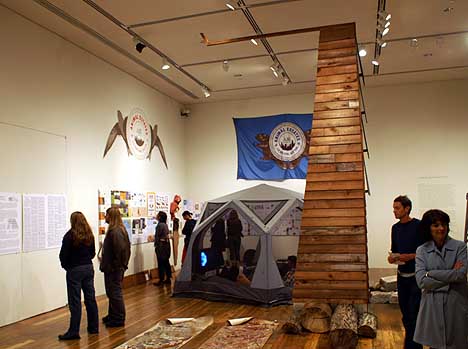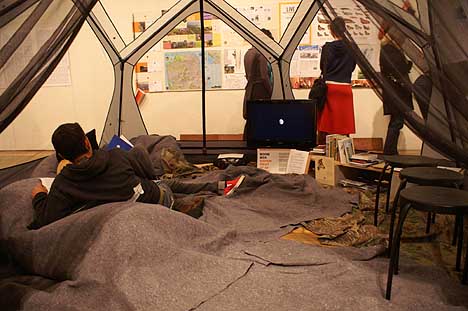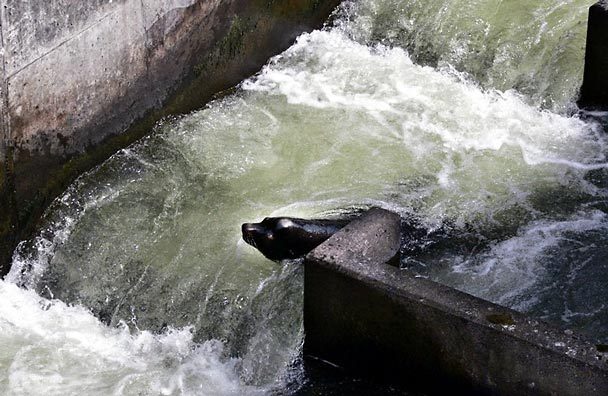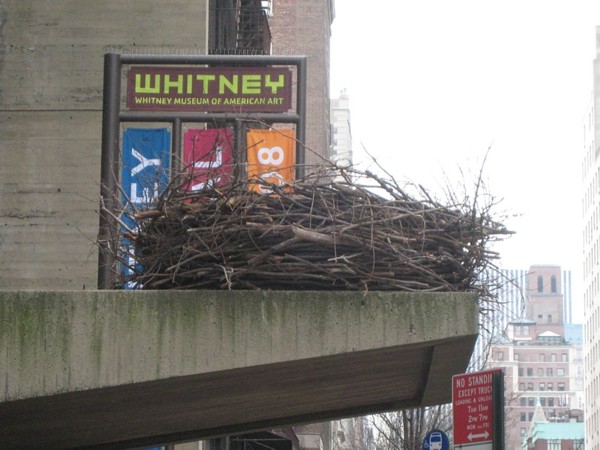
|
||
|
Portland art blog + news + exhibition reviews + galleries + contemporary northwest art
|
||
Fritz Haeg Interview at Reed College  Fritz Haeg's Animal Estates @ Reed's Cooley gallery Fritz Haeg is one of those people for whom definitions like; architect, artist, curator and activist, miss the broader picture of his efforts. For example, even though he was part of the 2008 Whitney Biennial and will be addressing the Frieze art fair this year, he could care less about conquering the art world. Instead, he wants to change the way we see and engage the world and his contribution to the Suddenly: Where We Live Now show at Reed's Cooley Gallery is both a resource and a prompt for engagement. In this show about understanding our shared environment and context Fritz's Animal Estates projects draw attention to many the wild animals that also live in Portland. The show end's tomorrow at 6:00 (with Fritz in attendance) so get on down to see this show while you still can. Jeff: Tell me about the Animal Estates project at the Cooley gallery's Suddenly: where we live now? Fritz: On the perimeter there is this Animal Estates repository or archive where each city adds material and it keeps growing from city to city. Each place is represented in very different ways.  geodesic tent …and what will be in here (inside the geodesic dome tent) is the reading library where there will be more books. Books on wildlife native to Portland, but because the archive has been in other cities there will be information on New York, San Francisco and Cambridge as well. The tent is always the headquarters for the project as well as a place to watch a local video on the Vaux Swifts at Chapman (a school in NW Portland). The swifts are kinda the touchstone for the project in Portland. In each city I do an Animal Estates project I spend a while finding local wildlife experts and talking to them. Just kinda grilling them on stories of urban wildlife and getting a sense of the place and try to determine who the appropriate animal clients would be in this region? And that's thinking about a few things like what animals used to live here? I also look at what animals are dependent on manmade structures or will be able to adapt and move into manmade structures. It seems like every city has its iconic animal that everybody talks about and say oh my god, you have those here? Like in San Francisco they have sea lions.  Sea Lion at Bonneville Dam, 2006 Photo Rick Bowmer / AP Jeff: yeah, we have them here occasionally; they have been wreaking havoc at the Bonneville Dam up the Columbia River. They use the dams to catch salmon as they run up the river to spawn. Occasionally, we have had Orcas that come up the Willamette river too, which worries me because until the Big Pipe project is done the Willamette is kinda scary from a pollution standpoint. Fritz: Yeah the runoff problem is the same in LA Jeff: Portland is just starting to engage the Willamette… LA kinda paved over and drank the Los Angeles river dry. Here the Willamette River is visible especially from all of the bridges but we haven't really celebrated our waterfront fully… an Orca swimming around kinda makes you think about a different kind of out of town guest. We also have lots a raccoons in the NW 21st restaurant district and Peregrine falcons on the Freemont bridge… sometimes I'm driving along and I look out the window and there's a falcon flying parallel to me at 55mph. It's pretty thrilling. Then we have these giant banana slugs Fritz: Yeah I've taken some pictures of them, they are beautiful… amazing Jeff: they get huge up in Forest Park, there are deer up there too. It is a huge for a city park. Fritz: They are so cool… each project manifests itself differently in each city because it's focused mostly on what kind of structures are people already making for animals. In San Francisco there were cover boards for the salamander or a pile of brush for the California quail and of course the sea lion floats at the marina. But mostly the focus at SFMOMA was a series of weekly events related to the animals, such as a workshop with Feral Childe to make these salamander hoodies for kids which you see here, a movement workshop with the dancers from Anna Halprin's Sea Ranch Collective and a writing workshop with 826 Valencia.  Haeg's Eagle Nest @ Whitney Biennial 2008 It was very different than the project in New York, which was all about making these structures for animals that used to live there in front of the Whitney Museum in a very sculptural way. The eagle's nest for the Whitney, which is the only piece I've ever sold, and the beehives are really memorials. Those animals are probably not coming back to Manhattan. Whereas, the project in San Francisco it was more about these events about things that were already happening there, the sea lions have an ongoing presence on the waterfront. In Portland Ive just found wonderful people to work with who have been advising me for months now. One of these first things someone mentioned was the snag and how important that was to the Pacific Northwest. It's a dead tree. Jeff: Nurse logs that serve as catalysts for everything else… Fritz: and of course those are the first things that get removed so the Animal Estates for Portland is a kind of condo tower for seven different species, a new snag. So I did a lot of research about each animal and what they need and designed this structure that approximates the kind of home they would have in a dead tree. So there will be a poster inviting everyone in Portland to design their own snag for their own properties. They can then send in their designs with their pictures and we will post them on the wall and on the website. We already have a few schools and people that we know will be building them but they can be wildly different than this (points to his snag). But they will have a pdf online with a lot of resource materials as to what these animals need. For example, this design on display here really started with the swifts who tend to roost on the insides of snags so they go in the top in the chimney. And these here (louvered area on the side) are for the silver haired bats. This down here is habitat for the snakes and it will be covered with rocks. The Orange-Rumped Bumblebee's use this pipe and the snail eating ground beetles live under these boards. Lastly, the Olive Sided Flycatcher uses this extended perch, they like to sit high above and swoop down. Jeff: The Flycatcher is a bird? Fritz: Yes. Then this whole condo will be installed somewhere in Portland after this show is over. The whole project is kept simple so it can be executed in wildly different ways in different places. The garden project was the same it's a basic idea that can be done differently anywhere. I also like how the snag acknowledges the significance of death in the natural process. Jeff: Then there's always this question as to whether what you are doing, is it art or not? Usually if you have to ask the question, it is. Fritz: right Jeff: But how do you see yourself? You started with architecture. Then the Edible Estates which was rogue gardening Fritz: It's interesting to me, on one hand I think my work is based purely on impulses of what I think I need to do and Ill do the work then people can figure out how they want to classify it. I purposefully do no want to sit comfortably within one discipline. I asked myself if it was possible to create work that could simultaneously bridge an incredibly broad audience like the national evening news, but at the same time be right in line with forward thinking and more narrow groups. For example, the Edible Estates project, where we create gardens in what was once a typical lawn… everyone understands that, a child understands that. Those garden projects are political projects and art projects, who cares really how you define it. It is the ideas that matter. I'm interested in making art that is almost Trojan (horse) in a way, and you just roll it out and people take it into their lives. For example the garden projects are written about the all the time in the main stream press and it isn't even mentioned that they are commissioned by major museums and that's great they don't need to write about that. In the art world they can be written about and they don't need to know that it's a part of a broader movement of gardeners. It is about turning these lawns into places where you can grow your own food and the ways that can affect the way people treat the land around them and the food they eat. Jeff: for so long people have been micro marketed to and instead... in my mind your are more of a macro "resource node", you also give people permission to break from conforming traditions. It's like you are building ownership of the ideas into the people who encounter these Animal or Edible Estates. It's about how the work effects people's consciousness of animals or food in their midst, not whether you had a show or not. You make food production and wild animals more present but it is not like you are taking credit for sea lions, falcons, bumblebees or squash in people's front yards. It's almost like you are an activist without a specific agenda… just a general awareness and interaction goal. I grew up surrounded by John Muir's legacy and it always seemed like the difference between artist and ecologist could be pretty minor. Look at Ansel Adams or Walden and who knows what the planet would have looked like if it weren't for the romantic poets as the industrial revolution took hold? Each created an awareness through their work, it isn't like Adams invented mountain photography but he stunned people into a greater sense of awareness. Fritz: It's interesting to me how different disciplines want to wall them selves off. Like, "How do we solve the painting problem or the structure problem?" Those aren't problems. If I have to make a video, I make a video. If I have to design a building, I design a building. I don't have to define myself by whatever media I happen to use for a project. The art world itself isn't all that interesting; it's just a vehicle to a larger conversation. Posted by Jeff Jahn on October 04, 2008 at 16:31 | Comments (1) Comments Thank you for the very informative interview. I had no idea that there were sea lions in San Francisco, all I did when I lived there was take acid on Haight st.xo Posted by: clarklovins Post a comment Thanks for signing in, . Now you can comment. (sign out)
(If you haven't left a comment here before, you may need to be approved by
the site owner before your comment will appear. Until then, it won't appear
on the entry. Thanks for waiting.)
|
| s p o n s o r s |
 |
 |
 |
 |
 |
 |
 |
 |
 |
 |
 |
 |
 |
 |
 |
 |

|
Site Design: Jennifer Armbrust | • | Site Development: Philippe Blanc & Katherine Bovee | |


![[TypeKey Profile Page]](http://www.portlandart.net/nav-commenters.gif)